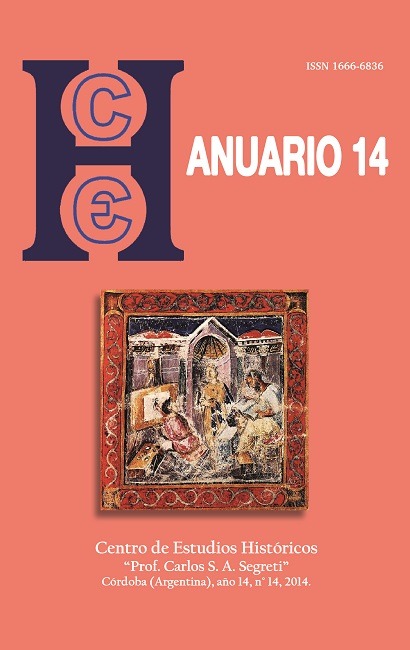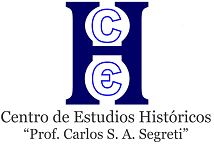The monastic community as synonymous with wisdom and holiness: the cenobites and the monastic rule of Isidore of Seville (7th century)
DOI:
https://doi.org/10.52885/2683-9164.v0.n14.22139Keywords:
Late Antiquity, monasticism, coenobitism, Isidore of SevilleAbstract
The forms of Christian monastic life were widely extended during the Late Antiquity (II/VIII centuries) in the Mediterranean world. Among the existing rules in the context of the Visigothic kingdom (VI/VII centuries), in this study we aim to emphasize the monastic rule of Isidore of Seville, one of the most noticeable figures of the history of the Visigothic Hispania. Based on the Isidorian rule, this article seeks to find the elements available in the Bishop of Seville’s work, which allow the characterization of the binomial monks/uiri sancti according to the coenobitical perspective, and recognized by the ecclesiastical hierarchies.
Downloads
References
AGOSTI G., “Classicism,Paideia, Religion”, Rita LIZZI TESTA, The Strange Death of Pagan Rome, Turnhout, Brepols, 2013.
BOWERSOCK, P. BROWN G. W., Oleg GRABAR, Interpreting Late Antiquity. Essays on the Postclassical World, Cambridge-London, Harvard University Press, 2001.
BROWN P., O Fim do Mundo Clássico. De Marco Aurélio a Maomé, Lisboa, Editorial Verbo, 1972.
CAMERON Alan, “Paganism and literature in late fourth century Rome”, REVERDIN Olivier , Christianisme et formes littéraires de l’Antiquité Tardive en Occident, Vandoeuvres-Genève, Entretiens sur l’Antiquité Classique, 1976.
CAMERON Averil, “Remaking the past”, BOWERSOCK Glen W., BROWN Peter y GRABAR Oleg, Interpreting Late Antiquity. Essays on the Postclassical World, Cambridge-London, Harvard University Press, 2001.
CANER D., Wandering, begging Monks. Spiritual authority and the promotion of Monasticism in Late Antiquity, Berkeley – Los Angeles – London, University of California Press, 2002.
CAZIER P., Isidore de Séville et la naissance de l’Espagne catholique, Paris, Beauchesne, 1994.
CODOÑER MERINO C., Obras Completas. Sulpicio Severo, Madrid, Tecnos, 1987.
DÍAZ MARTÍNEZ P.C., “Integración cultural y atención social en el monacato visigodo”, Los Visigodos y su mundo – Arqueologia – Paleontologia – Etnografia, Madrid, Comunidad de Madrid, 1998.
FEVRIER P.-A, “Une approche de la conversión des élites au IV esiècle: Le decor de la mort”, La Meditérrané de Paul-Albert Février, Roma, École Française de Rome, 1996.
FORMISANO Marco, “Late Antiquity, new departures”, HEXTER Ralph J. y TOWNSEND David, The Oxford handbook of Medieval Latin Literature, Oxford, Oxford University Press, 2011.
FRANKFURTER D., “Hagiography and the reconstruction of local religion in Late Antique Egypt: memories, inventions, and landscapes”, Jitse DIJKSTRA & Mathilde VAN DIJK, The Encroaching Desert. Egyptian Hagiography and the Medieval West, Leiden-Boston, Brill, 2006.
FRIGHETTO R., A Antiguidade Tardia. Roma e as monarquias romano-bárbaras numa época de transformações (séculos II – VIII), Curitiba, Juruá Editora, 2012.
LIZZI TESTA R., “The Late Antique Bishop: Image and reality”, Philip ROUSSEAU,A Companion to Late Antiquity, Oxford, Blackwell, 2009.
LOMAS SALMONTE F. J. , Secessus in villam: la alternativa pagana al ascetismo cristiano en el círculo de Ausonio, Antiguedad y Cristianismo VII – Cristianismo y aculturación en tiempos del Imperio Romano, Murcia, Ediciones Universidad de Murcia, 1990.
LOZANO A., Asia Menor en época helenístico-romana.Panorama religioso, Cristianismo Primitivo y Religiones Mistéricas, Madrid, Catedra, 1995.
MOMIGLIANO A., L’Età del trapasso fra storiografia antica e storiografia medievale (320-550 D.C.), La Storiografia Altomedievale – Settimane di studio del centro italiano sull’alto medioevo XVII, Spoleto, CISAM, 1970.
RAMOS-LISSON D., “Alegorismo pagano y alegorismo cristiano en Orígenes. La polémica contra Celso”, Antiguedad y Cristianismo VII – Cristianismo y aculturación en tiempos del Imperio Romano, Murcia, Ediciones Universidad de Murcia, 1990.
RAPP C., Holy Bishops in Late Antiquity. The nature of Christian leadership in an age of transition, Berkeley –Los Angeles – London, University of California Press, 2013.
RAPP C., “Desert, city, and countryside in the early Christian imagination”, Jitse DIJKSTRA & Mathilde VAN DIJK, The Encroaching Desert. Egyptian Hagiography and the Medieval West, Leiden Boston, Brill, 2006.
RAPP C., “The origins of hagiography and the literature of early monasticism: purpose and genre between tradition and innovation”, Christopher KELLY, Richard FLOWER & Michael Stuart WILLIAMS, Unclassical traditions volume I. Alternatives to the classical past in Late Antiquity, Cambridge, Cambridge University Press, 2010.
RAPP C., “City and citizenship as Christian concepts of community in Late Antiquity”, Claudia RAPP & H. A. DRAKE, The city in the classical and post-classical world. Changing contexts of power and identity, Cambridge, Cambridge University Press, 2014.
ROUSSEAU P., Ascetics, Authority and the Church in the age of Jerome and Cassian, Notre Dame, University of Notre Dame Press, 2010.
SANCHEZ-SALOR E., Historiografía latino-cristiana. Principios contenido forma, Roma, L’Erma, 2006.
SERNA GONZÁLEZ C. ‘Regula Benedicti’ 73 y el prólogo de ‘Regula Isidori’. A propósito de las fuentes literarias de las reglas monásticas”, Antigüedad y Cristianismo III. Los Visigodos. Historia y Civilización, Murcia, Ediciones Universidad de Murcia, 1986.
TEJA R., “?Romanos o Cristianos? La apropiación de la identidad romana por el cristianismo”, Gilvan Ventura da SILVA & Érica SILVA, Fronteiras e identidades no Imperio Romano. Aspectos sociopolíticos e religiosos, Vitória, GPM/UFES, 2015.
Downloads
Published
Issue
Section
License
Aquellos autores/as que tengan publicaciones con esta revista, aceptan los términos siguientes:
- Los autores/as conservarán sus derechos de autor y garantizarán a la revista el derecho de primera publicación de su obra, el cuál estará simultáneamente sujeto a una Licencia de reconocimiento de Creative Commons. Se puede compartir, copiar, distribuir, ejecutar y comunicar públicamente la obra, siempre que: a) se cite la autoría y la fuente original de su publicación (revista, editorial y URL de la obra); b) no se use para fines comerciales; c) no se altere, transforme o genere una obra derivada a partir de esta obra.
- Los autores/as podrán adoptar otros acuerdos de licencia no exclusiva de distribución de la versión de la obra publicada (p. ej.: depositarla en un archivo telemático institucional o publicarla en un volumen monográfico) siempre que se indique la publicación inicial en esta revista.
- Se permite y recomienda a los autores/as difundir su obra a través de Internet (p. ej.: en archivos telemáticos institucionales o en su página web) después del proceso de publicación, lo cual puede producir intercambios interesantes y aumentar las citas de la obra publicada. (Véase El efecto del acceso abierto).









